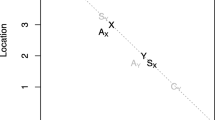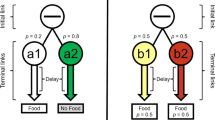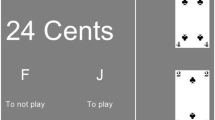Abstract
In a recent article which appeared in this journal, Biederman and Furedy (1976) have challenged the validity of many studies dealing with signaled and unsignaled shock schedules. The merits of Biederman and Furedy’s arguments are discussed here. Furedy and Biederman have been both careless and selective in their reporting of research. A careful reading of the existing literature is sufficient to counter the criticisms of the studies they have reported.
Similar content being viewed by others
References
SAFARJAN, W. R., & D’AMATO, M. R. 1975. Discriminated shock-free periods as the controlling variable in preference for signaled shock. Paper presented at the annual meetings of the Eastern Psychological Association, New York.
ARABIAN, D. M., & DESIDERATO, O. 1975. Preference for signaled shock: A test of two hypotheses. Animal Learning and Behavior, 3, 191–195.
AZRIN, N. H. 1956. Some effects of two intermittent schedules of immediate and non-immediate punishment. Journal of Psychology, 42, 3–21.
BADIA, P., COKER, C. C., & HARSH, J. 1973. Choice of higher density signaled shock over lower density unsignaled shock. Journal of the Experimental Analysis of Behavior, 20, 47–55.
BADIA, P., & CULBERTSON, S. 1970. Behavioral effects of signaled vs. unsignaled shock during escape training in the rat. Journal of Comparative and Physiological Psychology, 72, 216–222.
BADIA, P., & CULBERTSON, S. 1972. The relative aversiveness of signaled vs. unsignaled escapable and inescapable shock. Journal of the Experimental Analysis of Behavior, 17, 462–471.
BADIA, P., CULBERTSON, S., & HARSH, J. 1973. Choice of longer or stronger signaled shock over shorter or weaker unsignaled shock. Journal of the Experimental Analysis of Behavior, 19, 25–32.
BADIA, P., CULBERTSON, S., & LEWIS, P. 1971. The relative aversiveness of signaled vs. unsignaled avoidance. Journal of the Experimental Analysis of Behavior, 16, 113–121.
BADIA, P., & HARSH, J. 1977a. Preference for signaled over unsignaled shock schedules: A reply to Furedy and Biederman. Bulletin of the Psychonomic Society, 10, 13–16.
BADIA, P., & HARSH, J. 1977b. Further comments concerning perference for signaled shock conditions. Bulletin of the Psychonomic Society, 10, 17–20.
BADIA, P., HARSH, J., & COKER, C. C. 1975. Choosing between fixed time and variable time shock. Learning and Motivation, 6, 264–278.
BADIA, P., HARSH, J., COKER, C. C., & ABBOTT, B. 1976. Choice and the dependability of stimuli that predict shock and safety. Journal of the Experimental Analysis of Behavior, 26, 95–111.
BIEDERMAN, G. B., & FUREDY, J. J. 1976. Preference for signaled shock in rats? Instrumentation and methodological errors in the archival literature. The Psychological Record, 26, 501–514.
FISHER, C., & BADIA, P. 1975. Preference for signaled or unsignaled shock in goldfish. Bulletin of the Psychonomic Society, 6, 195–197.
FUREDY, J. J., & BIEDERMAN, G. B. 1976. Preference-for-signaled-shock phenomenon: Direct and indirect evidence for modifiability factors in the shuttlebox. Animal Learning and Behavior, 4, 1–5.
GRIFFIN, P., HONAKER, M., JONES, D. E., & PYNES, L. T. 1974. Preference for signaled vs. unsignaled shock in pigeons with implanted electrodes. Bulletin of the Psychonomic Society, 4, 141–143.
HARSH, J., & BADIA, P. 1974. A concurrent analysis of the aversive and reinforcing characteristics of a signaled shock schedule. Animal Learning and Behavior, 4, 1–5.
HARSH, J., & BADIA, P. 1975. Choice for signaled over unsignaled shock as a function of shock intensity. Journal of the Experimental Analysis of Behavior, 23, 349–355.
HARSH, J., & BADIA, P. 1976. A temporal parameter influencing choice between signaled and unsignaled shock schedules. Journal of the Experimental Analysis of Behavior, 25, 327–333.
HYMOWITZ, N. 1973. Preference for signaled electric shock. Proceedings of the 81st Annual Convention of the American Psychological Association, 847–848.
LEWIS, P., & GARDNER, E. T. 1977. The reliability of preference for signaled shock. Bulletin of the Psychonomic Society, 9, 135–138.
MACDONALD, L., & BARON, A. 1973. A rate measure of the relative aversiveness of signaled vs. unsignaled shock. Journal of the Experimental Analysis of Behavior, 19, 33–38.
MILLER, R. R., DANIEL, D., & BERK, A. M. 1974. Successive reversals of a discriminated preference for signaled tailshock. Animal Learning and Behavior, 2, 271–274.
MILLER, R. R., MARLIN, N. A., & BERK, A. M. In press. Reliability and sources of the preference-for signaled-shock phenomenon. Animal Learning and Behavior.
PERKINS, C. C., Jr., SEYMANN, R. G., LEVIS, C. J., & SPËNCER, H.. R., Jr. 1966. Factors affecting preference for signal-shock over shock-signal. Journal of Experimental Psychology, 72, 190–196.
SELIGMAN, M. E. P. 1968. Chronic fear produced by unpredictable electric shock. Journal of Comparative and Physiological Psychology, 66, 402–411.
WEISS, J. M. 1970. Somatic effects of predictable and unpredictable shock. Psychosomatic Medicine, 32, 397–408.
Author information
Authors and Affiliations
Additional information
Preparation of this article was supported by a grant from the Research Foundation of the State University of New York. The author gratefully acknowledges the helpful comments of Pietro Badia.
Rights and permissions
About this article
Cite this article
Harsh, J. Preference for Signaled Shock: A Well Established and Reliable Phenomenon. Psychol Rec 28, 281–289 (1978). https://doi.org/10.1007/BF03394537
Published:
Issue Date:
DOI: https://doi.org/10.1007/BF03394537




